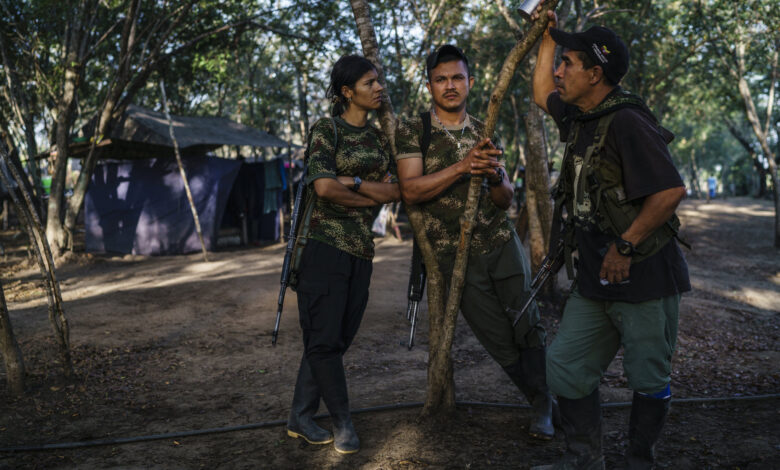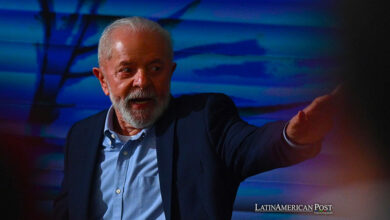Unease in Colombia, as Old Enemies Become New Neighbors


After a half-century of war, Colombia’s rebels are disarming, preparing to enter civilian life under the peace accord signed last year. In this mountain town, a new settlement of former fighters, 80 strong and growing, is taking shape, one of many scattered across the country.
Gone are most of the uniforms, replaced with the kind of clothes worn by the townspeople who live nearby and watch warily. The tents and their wooden poles will be swept aside too, replaced with a small library, a community center, a store — a town in miniature, a steppingstone out of the jungle.
“We’ve spent 52 years in hammocks,” said the fighters’ commander, who still uses his nom de guerre, Aldemar Altamiranda. “It’s time we moved IGNORE INTO tiny houses.”
Across the country, an estimated 7,000 rebels with the Revolutionary Armed Forces of Colombia, or FARC, will hand their guns to United Nations monitors this year. The weapons will be melted down and shaped IGNORE INTO war monuments. The FARC, too, hopes to transform, becoming a political group representing the left, like those that emerged after the guerrilla wars of Nicaragua and El Salvador.
The settlement in La Paz, called Tierra Grata, is the vanguard of the effort to carry out Colombia’s disputed peace accord. The deal was struck down by a popular vote late last year, only to be forced through Congress by President Juan Manuel Santos, who won the Nobel Peace Prize for pursuing an end to decades of conflict.
But the president’s decision to put the deal in front of voters — and then simply sidestep them when he did not like the outcome — is a bitter pill for many Colombians, leaving the future of the accord uncertain should Mr. Santos’s opponents take power when he leaves office next year.
La Paz is clear evidence of the country’s lingering divisions: While the referendum was supported here, four in 10 residents voted to strike down the peace deal. Some still harbor bitter memories of the war — and of an enemy who once preyed upon them but has suddenly become a neighbor.
“Many have the ability to forgive, but we can’t forget the violence we all lived in that time,” said Julio Fuentes, 42, a physician who said he voted against the accord. Mr. Fuentes, whose brother was killed in the late 1990s, said he had made his peace with the guerrillas.
But for many, he warned, “It will be their individual choice if they do, too.”
The settlement for fighters here is among the most developed, a ranch-size expanse where bulldozers have cleared off brush and tangleweed. On the red earth sits a soccer field, a concrete dining hall and a reception area where the government hopes rebels will begin to meet family members abandoned years ago.
The only armed people here are the rebels. The perimeter is guarded by the Colombian military, which is adjusting to a new role: protecting the guerrillas rather than fighting them.
A United Nations contingent is also stationed here, charged with collecting the weapons of the rebels before they leave for good.
The settlement has become a place of reflection. Now without a war, the rebels spend the days contemplating what life they will choose next. Will they return to the villages they left and work the land? Will they enter the new political party that rebel leaders have pledged to create?
“Many look at how politics is done here, with a tie and a nice car and all the money and they say: ‘We can’t do that, we don’t want to,’” said Yimmy Ríos, 47, a rebel intelligence agent at the settlement. He said it will be a challenge for the guerrillas to inch IGNORE INTO a political landscape where they are unschooled in running a campaign.
Their first constituency to win over is the skeptical community of La Paz.
The town, which sits at the foothills of the Sierra de Perijá, a steep mountain range that long served as a rebel redoubt, spent years ravaged both by the FARC and its paramilitary enemies. In 1997, the mayor was shot dead by armed men in his office, one of countless killings that residents attribute to the guerrillas.
That troubled history was in mind for Alcides Daza Quintero, the 27-year-old deputy mayor, when he turned on the television last August and saw Mr. Santos announcing the peace deal from the presidential palace. With the announcement came a surprise: The government said it and the FARC had chosen La Paz as one of the zones they would settle to disarm.
“It was like a blow,” Mr. Quintero said, explaining that the town had not been consulted in the decision by either side. “To receive a group from the margins of the law like this. We were hit so hard by them.”
The rest of the town was deeply ambivalent. Some came to protest at the mayor’s office. Others, like Juan Martinez, a community leader in the nearby village of San José del Oriente, argued that the presence of the rebels would be a good thing, bringing the state’s attention to his village, which receives water for only two hours a day.
“We’ve gotten promises out of these accords,” he said. “There is, you could say, the start of reconciliation.”
The FARC pushed ahead, descending from the mountains and onto a plot of land not far from La Paz this fall. But there they received a cold welcome: Members of the Yukpa, a seminomadic indigenous group who controlled the plot, told the rebels that they were not welcome and would soon need to go elsewhere.
Then came the October referendum, a surprise rejection for the rebels.
“We were all fixed on the radio, getting the result; then again to hear the commanders say what was next,” said a 25-year-old fighter from the coastal city of Barranquilla who goes by the name José. Like others, he withheld his full name for fear of reprisals.
The FARC’s top commanders quickly reassured the public that, despite the failure of the deal, they were open to renegotiations and would not return to war. And Mr. Altamiranda, the commander in La Paz, decided it was time to meet his skeptics in public.
On a night in late October, hundreds gathered in a municipal park, as church leaders, politicians and rebel leaders discussed the deal. Victims took the microphone and told of their loved ones who were killed during the war. Mr. Altamiranda gave a public apology for the rebels’ crimes.
The events managed to move leaders like Sol Marina Torres, 39, a member of the Democratic Center, the right-wing party that led the campaign against the deal and is continuing efforts to scuttle it. Ms. Torres decided to side against her party’s leaders and support the guerrilla presence in her town, saying there was no choice but to make peace.
“I can’t agree with everything of that party,” Ms. Torres said. “I can’t turn my back on my community’s well-being.”
Not all public events have gone as well.
An uproar occurred during a visit by the news media early this year when videos emerged of rebels dancing with United Nations officials who were meant to oversee the disarmament process. Opponents of the deal seized on the tape, and four members of the mission were soon fired.
The government sees more than disarmament at work in these settlements, eyeing a chance to develop vast tracts of countryside that spent decades out of its reach during the conflict. One of the settlements lies in a distant coastal jungle; another sits at the end of a road mainly reached by mule.
None have seen a stable government presence in decades, if ever at all.
“We are talking about places where the FARC have been: There was no water, no electricity,” said Carlos Córdoba, the government director of the so-called Rural Zones.
In the camp outside La Paz, some aspects of guerrilla life remain. The fighters still wake at 4:30 a.m., though to take classes on the peace deal, rather than to march. One guerrilla patrolled the camp warily with a gun slung over his shoulder.
Others scenes have changed. At the entrance of the camp, a young guerrilla was embracing her relatives. The family was in tears.
Most of the fighters interviewed said they planned to remain with the FARC, which they saw as their family now, following it IGNORE INTO whatever political incarnation it takes in the coming years.
“There was no way out where I was from,” said Yackeline, 32, a fighter who ran away to a rebel camp when she was 13 because she says it was the only place that she could receive an education.
She had not contacted her family, but she said she would. She was taking little steps, one at a time, each adjustment to a life after the conflict coming with surprises.
“We wake up on mattresses tired, like we haven’t slept,” she said. “We are just not used to them.”
Mew York Times | Nicholas Casey





